You are using an out of date browser. It may not display this or other websites correctly.
You should upgrade or use an alternative browser.
You should upgrade or use an alternative browser.
Alternate Aircraft of Nations
- Thread starter Count of Crisco
- Start date
McPherson
Banned
No, I cannot. There are limits to what can be squeezed out of a Skua.Can you imagine an improved or enlarged version with a Hercules and 1000lb bombs. Heck even a Perseus 100 would give 1200hp and a significant increase in capability.
from Wiki.
Specifications (Skua Mk. II)[edit]

Skua L3007 in target tug markings, 1941
Data from Blackburn Aircraft since 1909[15]
General characteristics
Performance
- Crew: 2
- Length: 35 ft 7 in (10.85 m)
- Wingspan: 46 ft 2 in (14.07 m)
- Height: 12 ft 6 in (3.81 m)
- Wing area: 319 sq ft (29.6 m2)
- Airfoil: root: NACA 2416; tip: NACA 2409[16]
- Empty weight: 5,496 lb (2,493 kg)
- Gross weight: 8,228 lb (3,732 kg)
- Powerplant: 1 × Bristol Perseus XII 9-cylinder air-cooled radial sleeve-valve piston engine, 890 hp (660 kW)
- Propellers: 3-bladed variable-pitch propeller
Armament
- Maximum speed: 225 mph (362 km/h, 196 kn) at 6,500 ft (1,981 m)
- Cruise speed: 187 mph (301 km/h, 162 kn) [17]
- Range: 760 mi (1,220 km, 660 nmi) [18]
- Service ceiling: 20,200 ft (6,200 m)
- Rate of climb: 1,580 ft/min (8.0 m/s)
- Guns: [19]
- 4 × 0.303 in (7.7 mm) forward-firing Browning machine guns with 600 rounds per gun
- 1 × 0.303 in (7.7 mm) Lewis or Vickers K machine gun on flexible mount in rear cockpit
- Bombs: 1 × 500 lb (230 kg) semi-armour piercing bomb under fuselage or 8 × 30 lb (14 kg) practice bombs under wings[19]
Comparison... also from Wiki
Some things to consider... A Bristol Hercules masses 150 kg more than the Wright R1820. The Dauntless carries more fuel compared to a Skua as a result. The wings give eerily similar lift, but the better less draggy and more pancake shaped Dauntless airframe provides added cylinder lift so it can carry more bombload further.Specifications (SBD-5)[edit]

Data from McDonnell Douglas aircraft since 1920 : Volume I[59]
General characteristics
Performance
- Crew: 2
- Length: 33 ft 1.25 in (10.0902 m)
- Wingspan: 41 ft 6.375 in (12.65873 m)
- Height: 13 ft 7 in (4.14 m)
- Wing area: 325 sq ft (30.2 m2)
- Airfoil: root: NACA 2415; tip: NACA 2407[60]
- Empty weight: 6,404 lb (2,905 kg)
- Gross weight: 9,359 lb (4,245 kg)
- Max takeoff weight: 10,700 lb (4,853 kg)
- Fuel capacity: 260 US gal (220 imp gal; 980 l) in non-metallic self-sealing fuel tanks
- Powerplant: 1 × Wright R-1820-60 Cyclone 9-cylinder air-cooled radial piston engine, 1,200 hp (890 kW)
- Propellers: 3-bladed Hamilton-Standard constant-speed propeller
Armament
- Maximum speed: 255 mph (410 km/h, 222 kn) at 14,000 ft (4,300 m)
- Cruise speed: 185 mph (298 km/h, 161 kn)
- Range: 1,115 mi (1,794 km, 969 nmi)
- Ferry range: 1,565 mi (2,519 km, 1,360 nmi)
- Service ceiling: 25,530 ft (7,780 m)
- Rate of climb: 1,700 ft/min (8.6 m/s)
- Wing loading: 28.8 lb/sq ft (141 kg/m2)
- Power/mass: 0.128 hp/lb (0.210 kW/kg)
- Guns: ** 2 × 0.50 in (12.7 mm) forward-firing synchronized Browning M2machine guns in engine cowling
- 2 × 0.30 in (7.62 mm) flexible-mounted Browning M1919 machine guns in rear
- Bombs: 2,250 lb (1,020 kg) of bombs
To get a Dauntless bombload and range out of a Skua, one has to give up the guy in back, jettison the British radio and nav-aids and use American gear, and one has to install a Wright in the nose. That is not possible. Better to refine the Skua airframe and look at mating the Bristol Taurus to the bird.
The Nakajima Ki-87
The Heinkel He 119 was an experimental single-propeller monoplane with two coupled engines, developed in Germany. A private venture by Heinkel to test radical ideas by the Günter brothers, the He 119 was originally intended to act as an unarmed reconnaissance bomber capable of eluding all fighters due to its high performance.
Developed to utilise the combine engine of the Daimler-Benz DB601 engines mounted above the wing centre-section within the fuselage, mounted together within a common mount (the starboard component engine having a "mirror-image" centrifugal supercharger) with a common gear reduction unit fitted to the front ends of each component engine, forming a drive unit known as the DB606, the first German aircraft to use the "high-power" power plant system. meant to provide German aircraft with an aviation power plant design of over-1,500 kW (2,000 PS) output capability, but weighing 1.5 tonnes apiece.
The aircraft featured a revolutionary evaporative cooling system as well, with radiators under the skin of the wing, cooled by the normal airflow. However, this really wasn’t sufficient as was found with the V1 prototype, so a retractable radiator of conventional form was added under the fuselage.
Heinkel developed the aircraft but the Reichsluftfahrtministerium (RLM) had no interest in it. Heinkel developed several record breaking versions of the aircraft both as land and float plane based versions. However, they failed to achieve their records due to accidents.
Japan however was interested in acquiring new technology and purchased two versions of the He119, the V7 and the V8 in 1940. The Imperial Japanese Army gave them to the Nakajima combine with instructions to study them and develop their own versions. Nakajima already had licence rights to produce the DB601 engine so the DB606 was quite within their reach. What the Imperial Japanese Army didn’t like that much was the evaporative cooling system but accepted that was what made the He119 a world beater when combined with it’s power plant. They also didn’t like that the aircraft was unarmed and insisted a tail turret be incorporated in it’s design. The result was the Nakajima Ki-87, a medium sized reconnaissance bomber able to match the performance of the Imperial Japanese Navy’s Mitsubishi Ki-46.
Problems became however apparent when the aircraft was introduced into limited service in late 1941. In theory it could fly higher, faster than most Allied fighters at that point in the war. The engines however were unreliable and rarely managed to produce their rated power. The turret was so cramped that only the smallest airman could be accommodated. The evaporative cooling system actually proved relatively simple and troublefree. The aircraft only saw limited service as a consequence and failed to achieve any successes against the enemy.
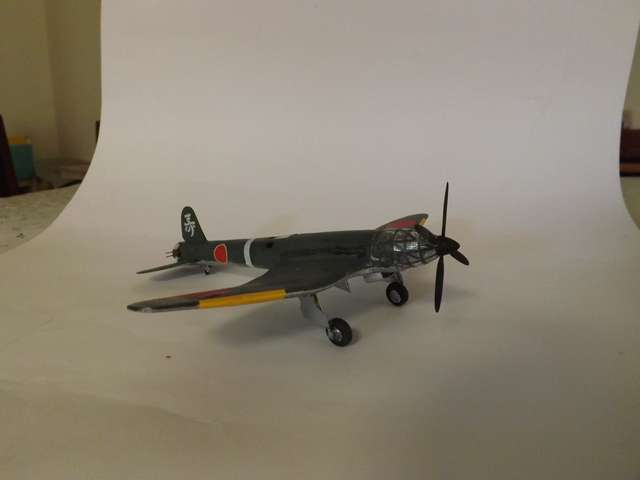
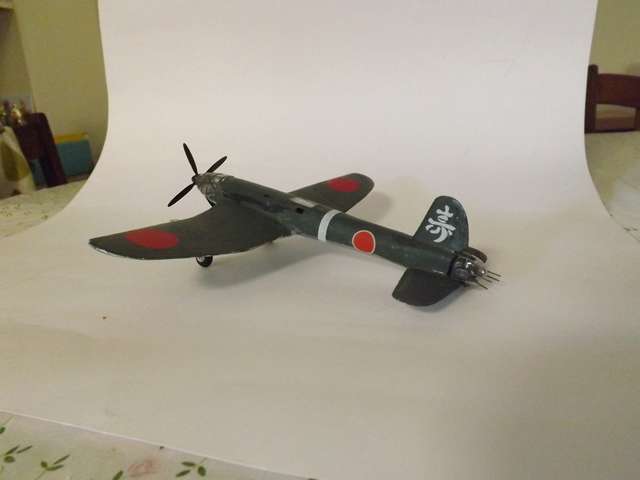
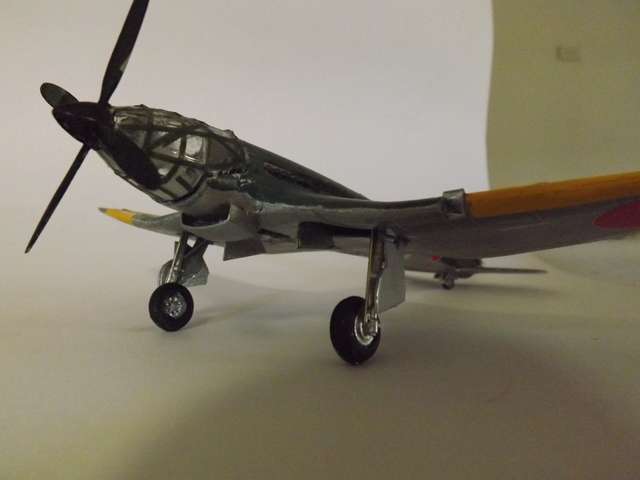

The Kit
The kit is the Valom He119. The turret is actually intended for the He177a5. The paint is by Vallejo and rattlecan. The markings are from the sparesbox.
The Heinkel He 119 was an experimental single-propeller monoplane with two coupled engines, developed in Germany. A private venture by Heinkel to test radical ideas by the Günter brothers, the He 119 was originally intended to act as an unarmed reconnaissance bomber capable of eluding all fighters due to its high performance.
Developed to utilise the combine engine of the Daimler-Benz DB601 engines mounted above the wing centre-section within the fuselage, mounted together within a common mount (the starboard component engine having a "mirror-image" centrifugal supercharger) with a common gear reduction unit fitted to the front ends of each component engine, forming a drive unit known as the DB606, the first German aircraft to use the "high-power" power plant system. meant to provide German aircraft with an aviation power plant design of over-1,500 kW (2,000 PS) output capability, but weighing 1.5 tonnes apiece.
The aircraft featured a revolutionary evaporative cooling system as well, with radiators under the skin of the wing, cooled by the normal airflow. However, this really wasn’t sufficient as was found with the V1 prototype, so a retractable radiator of conventional form was added under the fuselage.
Heinkel developed the aircraft but the Reichsluftfahrtministerium (RLM) had no interest in it. Heinkel developed several record breaking versions of the aircraft both as land and float plane based versions. However, they failed to achieve their records due to accidents.
Japan however was interested in acquiring new technology and purchased two versions of the He119, the V7 and the V8 in 1940. The Imperial Japanese Army gave them to the Nakajima combine with instructions to study them and develop their own versions. Nakajima already had licence rights to produce the DB601 engine so the DB606 was quite within their reach. What the Imperial Japanese Army didn’t like that much was the evaporative cooling system but accepted that was what made the He119 a world beater when combined with it’s power plant. They also didn’t like that the aircraft was unarmed and insisted a tail turret be incorporated in it’s design. The result was the Nakajima Ki-87, a medium sized reconnaissance bomber able to match the performance of the Imperial Japanese Navy’s Mitsubishi Ki-46.
Problems became however apparent when the aircraft was introduced into limited service in late 1941. In theory it could fly higher, faster than most Allied fighters at that point in the war. The engines however were unreliable and rarely managed to produce their rated power. The turret was so cramped that only the smallest airman could be accommodated. The evaporative cooling system actually proved relatively simple and troublefree. The aircraft only saw limited service as a consequence and failed to achieve any successes against the enemy.




The Kit
The kit is the Valom He119. The turret is actually intended for the He177a5. The paint is by Vallejo and rattlecan. The markings are from the sparesbox.
Considering when it would have been operational it would have needed a separate height finder Ariel. To ensure that they knew the altitude of any potential threat.
The Chengdu J-10 in Indonesian Service
In 1965, when the Communist Party of Indonesia overthrew the Sukarno Government and created the Peoples' Democratic Republic of Indonesia (PDRI) under President Untung bin Syamsuri who had lead the Revolution on 30 September 1965. He replaced President Sukarno soon afterwards. The Indonesian Air Force, became a largely Soviet equipped one. When the Soviet Union dissolved at the end of the Cold War Indonesia was left without a backer. They turned to China. China was quite prepared to support Indonesia.
The first Chinese aircraft that the Indonesians received was the Shenyang J-8, a Chinese version of the MiG-21, with two engines. Twin Guizhou WP-13B, a version of the Tumansky R-13, rated at 10,580 lbf thrust dry, 15,430 lbf with afterburner. This however was only a stop gap while more modern equipment was being developed. Indonesia received its first example of the Chengdu J-10 its successor in 2008.
The J-10 is a modern, lightweight fighter-bomber. the airframe's aerodynamic layout adopts a "tail-less canard delta" wing configuration. A large delta wing is mid-mounted towards the rear of the fuselage, while a pair of canards (or foreplanes) are mounted higher up and towards the front of the fuselage, behind and below the cockpit. This configuration provides very high agility, especially at low speeds, and also reduces stall speed, allowing for a lower airspeed during instrument approaches. A large vertical tail is present on top of the fuselage and small ventral fins underneath the fuselage provide further stability.
A large rectangular air intake is located underneath the fuselage, providing the air supply to the engine. Newer variants use a diverterless intake that does not require a splitter plate, and may reduce radar cross signature. Also under the fuselage and wings are 11 hardpoints, used for carrying various types of weaponry and drop-tanks containing extra fuel.
It is armed with internal armament consisting of a Gryazev-Shipunov GSh-23 twin-barrel cannon, located underneath the port side of the intake. Other weaponry and equipment is mounted externally on 11 hardpoints, to which 6,000 kg (13,228 lb) of either missiles and bombs, drop-tanks containing fuel, or other equipment such as avionics pods can be attached.[citation needed]
Air-to-air missiles deployed may include short-range air-to-air missiles such as the PL-8 and PL-10 (on J-10C), medium-range radar-guided air-to-air missiles such as the PL-12 and PL-15 (on J-10C), unguided and precision guided munitions such as laser-guided bombs, air-to-surface missile such as KD-88,[30] anti-ship missiles such as the YJ-91A[30] and anti-radiation missiles such as the YJ-91.
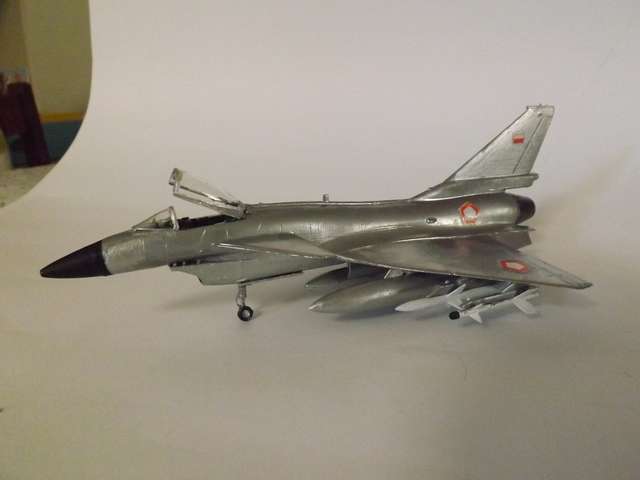

The Kit
The kit is the Trumpeter 1/72 scale kit. Painted with a rattlecan. Decals by Kit Speckman Enterprises.
In 1965, when the Communist Party of Indonesia overthrew the Sukarno Government and created the Peoples' Democratic Republic of Indonesia (PDRI) under President Untung bin Syamsuri who had lead the Revolution on 30 September 1965. He replaced President Sukarno soon afterwards. The Indonesian Air Force, became a largely Soviet equipped one. When the Soviet Union dissolved at the end of the Cold War Indonesia was left without a backer. They turned to China. China was quite prepared to support Indonesia.
The first Chinese aircraft that the Indonesians received was the Shenyang J-8, a Chinese version of the MiG-21, with two engines. Twin Guizhou WP-13B, a version of the Tumansky R-13, rated at 10,580 lbf thrust dry, 15,430 lbf with afterburner. This however was only a stop gap while more modern equipment was being developed. Indonesia received its first example of the Chengdu J-10 its successor in 2008.
The J-10 is a modern, lightweight fighter-bomber. the airframe's aerodynamic layout adopts a "tail-less canard delta" wing configuration. A large delta wing is mid-mounted towards the rear of the fuselage, while a pair of canards (or foreplanes) are mounted higher up and towards the front of the fuselage, behind and below the cockpit. This configuration provides very high agility, especially at low speeds, and also reduces stall speed, allowing for a lower airspeed during instrument approaches. A large vertical tail is present on top of the fuselage and small ventral fins underneath the fuselage provide further stability.
A large rectangular air intake is located underneath the fuselage, providing the air supply to the engine. Newer variants use a diverterless intake that does not require a splitter plate, and may reduce radar cross signature. Also under the fuselage and wings are 11 hardpoints, used for carrying various types of weaponry and drop-tanks containing extra fuel.
It is armed with internal armament consisting of a Gryazev-Shipunov GSh-23 twin-barrel cannon, located underneath the port side of the intake. Other weaponry and equipment is mounted externally on 11 hardpoints, to which 6,000 kg (13,228 lb) of either missiles and bombs, drop-tanks containing fuel, or other equipment such as avionics pods can be attached.[citation needed]
Air-to-air missiles deployed may include short-range air-to-air missiles such as the PL-8 and PL-10 (on J-10C), medium-range radar-guided air-to-air missiles such as the PL-12 and PL-15 (on J-10C), unguided and precision guided munitions such as laser-guided bombs, air-to-surface missile such as KD-88,[30] anti-ship missiles such as the YJ-91A[30] and anti-radiation missiles such as the YJ-91.


The Kit
The kit is the Trumpeter 1/72 scale kit. Painted with a rattlecan. Decals by Kit Speckman Enterprises.
Last edited:
Pangur
Donor
and that would certainly have gotten a response from AustraliaThe Chengdu J-10 in Indonesian Service
In 1965, when the Communist Party of Indonesia overthrew the Sukarno Government and created the Peoples' Democratic Republic of Indonesia (PDRI) under President Untung bin Syamsuri who had lead the Revolution on 30 September 1965. He replaced President Sukarno soon afterwards. The Indonesian Air Force, became a largely Soviet equipped one. When the Soviet Union dissolved at the end of the Cold War Indonesia was left without a backer. They turned to China. China was quite prepared to support Indonesia.
The first Chinese aircraft that the Indonesians received was the Shenyang J-8, a Chinese version of the MiG-21, with two engines. Twin Guizhou WP-13B, a version of the Tumansky R-13, rated at 10,580 lbf thrust dry, 15,430 lbf with afterburner. This however was only a stop gap while more modern equipment was being developed. Indonesia received its first example of the Chengdu J-10 its successor in 2008.
The J-10 is a modern, lightweight fighter-bomber. the airframe's aerodynamic layout adopts a "tail-less canard delta" wing configuration. A large delta wing is mid-mounted towards the rear of the fuselage, while a pair of canards (or foreplanes) are mounted higher up and towards the front of the fuselage, behind and below the cockpit. This configuration provides very high agility, especially at low speeds, and also reduces stall speed, allowing for a lower airspeed during instrument approaches. A large vertical tail is present on top of the fuselage and small ventral fins underneath the fuselage provide further stability.
A large rectangular air intake is located underneath the fuselage, providing the air supply to the engine. Newer variants use a diverterless intake that does not require a splitter plate, and may reduce radar cross signature. Also under the fuselage and wings are 11 hardpoints, used for carrying various types of weaponry and drop-tanks containing extra fuel.
It is armed with internal armament consisting of a Gryazev-Shipunov GSh-23 twin-barrel cannon, located underneath the port side of the intake. Other weaponry and equipment is mounted externally on 11 hardpoints, to which 6,000 kg (13,228 lb) of either missiles and bombs, drop-tanks containing fuel, or other equipment such as avionics pods can be attached.[citation needed]
Air-to-air missiles deployed may include short-range air-to-air missiles such as the PL-8 and PL-10 (on J-10C), medium-range radar-guided air-to-air missiles such as the PL-12 and PL-15 (on J-10C), unguided and precision guided munitions such as laser-guided bombs, air-to-surface missile such as KD-88,[30] anti-ship missiles such as the YJ-91A[30] and anti-radiation missiles such as the YJ-91.

https://imagizer.imageshack.com/img924/8017/B6ygMN.jpg[/img]
The Kit
The kit is the Trumpeter 1/72 scale kit. Painted with a rattlecan. Decals by Kit Speckman Enterprises.
What would that look like ?Considering when it would have been operational it would have needed a separate height finder Ariel. To ensure that they knew the altitude of any potential threat.
Like the EC-121 a separate ariel under or in front of the fuselage. They had an ariel for azimuth and an ariel for the height finding sets. Combined ariels didn't appear until the late 1960s.What would that look like ?
I believe the word you're looking for is aerial. However this picture on the fuselage of the E-36 would be memorable.Like the EC-121 a separate ariel under or in front of the fuselage. They had an ariel for azimuth and an ariel for the height finding sets. Combined ariels didn't appear until the late 1960s.
🤣🤣I believe the word you're looking for is aerial. However this picture on the fuselage of the E-36 would be memorable.View attachment 639664
Aaaaaaand the thread is doneI believe the word you're looking for is aerial. However this picture on the fuselage of the E-36 would be memorable.View attachment 639664
The Royal Navy and the Trent Powered Meteor
In 1945, desperate to get a jet powered aircraft aboard their carriers, the Lords of the Admiralty undertook trials with a Meteor I it was used for deck-handling tests aboard aircraft carrier HMS Pretoria Castle in late 1944. Flown by Captain Eric "Winkle” Brown in March 1945, a hooked Meteor III made the first jet landing and take off from an aircraft carrier on HMS Ocean. The results from these trials were such that they decided to order 200 Meteor IVs, a version which utilised the Derwent V engine. This new engine provided 3,500lb of thrust, a 50% increase on the power offered by the Derwent IV used in later Meteor IIIs. The result was a sprightly improvement in the Meteor III's desultory performance. The first Meteor IV prototype took to the air on 15 August 1945 and the test programme went so smoothly that it entered RN FAA squadron service on 1 June 1946, just in time to sail onboard HMS Illustrious to the Far East to take part in the planned invasion of the Japanese home islands. Able to carry 2,000lbs under each wing, armed with rockets or bombs and its 4 20mm cannon, the Meteor IV proved a considerable success both as a fighter-bomber and a fighter against the Japanese Kamikaze planes deployed against the Allied fleet off Japan.
However what isn’t known was that a flight of four Trent Turbo-prop powered Meteors also took part in the attack on the Japanese home islands. Equipped with two Trent engines, the Trent Meteor had a longer range and only a slightly lower speed than the normal Derwent powered versions. It could also carry the same load.
The newly developed RB.50 Trent propeller-turbine, or turboprop. Such a powerplant seemed to offer many of the advantages of turbine power (relative simplicity, high power and lack of vibration) combined with the proven capabilities of the propeller (high aerodynamic efficiency even up to quite high Mach numbers). Rolls-Royce therefore began to develop the experimental Trent in May 1944, using as the basis of the engine the centrifugal-flow Derwent turbojet which was to power the F.3 and later marks of the Meteor.
The Trent-Meteor needed little modification for the accommodation of the Trent powerplant, though the nacelles were somewhat larger, which, with the extra side area of the propellers, entailed the fitting of two small auxiliary fins towards the outboard ends of the tailplane to ensure directional stability. The Gloster Trent-Meteor first flew on September 20, 1945 and thereafter contributed greatly to the development of turbine engines as pure turbojets and as turboprops. In its first form, the Trent-Meteor was fitted with five-blade Rotol propellers, each having a diameter of 2.41m, though some reports claim a propeller with a diameter of 2.31m absorbing 750hp and leaving 454kg of residual thrust. Later, the aircraft was modified to accommodate propellers with a diameter of 1.49m, absorbing only 350hp and leaving a residual thrust of 635kg to emerge from a squeezed orifice. It had a range of over 590 miles as against the Meteor IV’s of 510 miles, with a top speed of 598 mph versus 580 mph of the Mk.IV.
The Trent engined Meteors were definitely an experimental aircraft with the pilot needing to juggle the controls between the thrust and the propeller setting. The Royal Navy was interested in them because of needing a replacement for their propeller powered aircraft in the strike role and decided to try them out in an operational test. The Fleet Air Arm found that only their most expert pilots could manage the juggling act and land the aircraft onto the carriers. So, they were sent. Four of the most expert pilots, including Eric “Winkle” Brown, who led the flight.
Equipped with bombs or rockets and four 20mm cannons the aircraft were near equal of the jet powered Meteor IVs which they accompanied to the far east. They failed to encounter any Japanese aircraft over Japan but they impressed the US Navy who arranged for a test flight on their return through the Panama Canal and the visit to Patuxent River Naval Base.
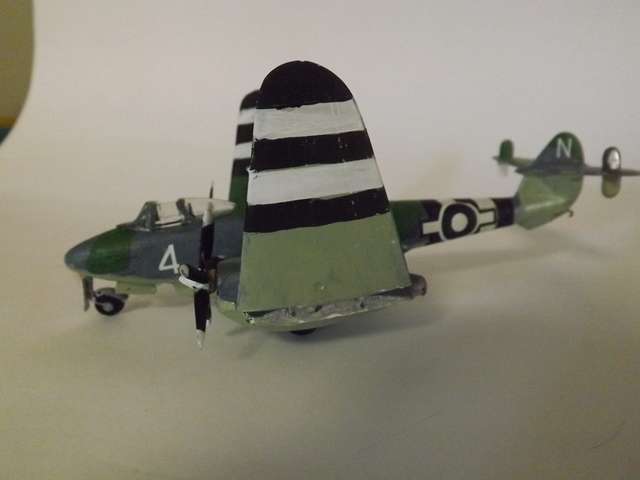
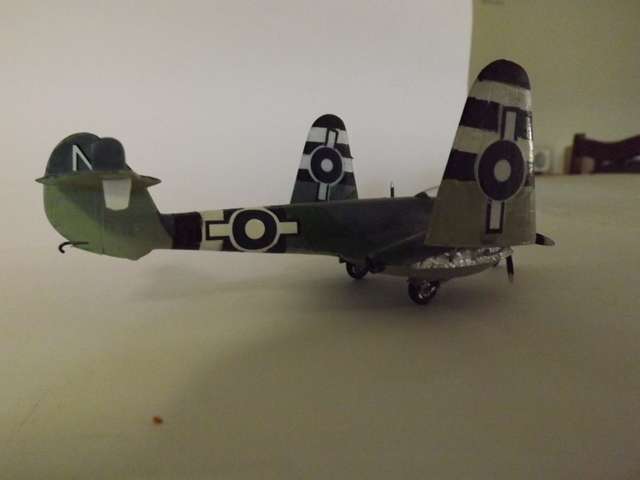
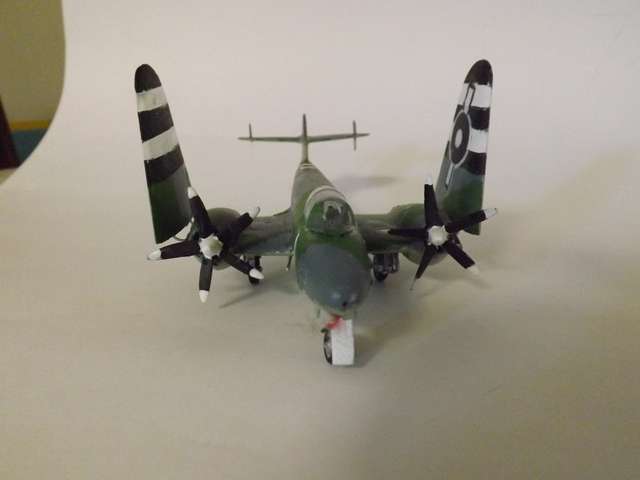

The Kit
The kit is the 1/72 MPM Trent Meteor. It was an interesting build. For some strange reason the undercarriage is misaligned with one leg ending up more forward than the other. Doesn’t distract from the model but it is, well, “odd”. I intended to arm it with 60 lb rockets but their really isn’t enough room and be able to paint the invasion stripes and put the markings on it. Oh, well, another time. Paint is Vallejo and Tamiya with a hairy stick. Decals from Kit Speckman Enterprises.
In 1945, desperate to get a jet powered aircraft aboard their carriers, the Lords of the Admiralty undertook trials with a Meteor I it was used for deck-handling tests aboard aircraft carrier HMS Pretoria Castle in late 1944. Flown by Captain Eric "Winkle” Brown in March 1945, a hooked Meteor III made the first jet landing and take off from an aircraft carrier on HMS Ocean. The results from these trials were such that they decided to order 200 Meteor IVs, a version which utilised the Derwent V engine. This new engine provided 3,500lb of thrust, a 50% increase on the power offered by the Derwent IV used in later Meteor IIIs. The result was a sprightly improvement in the Meteor III's desultory performance. The first Meteor IV prototype took to the air on 15 August 1945 and the test programme went so smoothly that it entered RN FAA squadron service on 1 June 1946, just in time to sail onboard HMS Illustrious to the Far East to take part in the planned invasion of the Japanese home islands. Able to carry 2,000lbs under each wing, armed with rockets or bombs and its 4 20mm cannon, the Meteor IV proved a considerable success both as a fighter-bomber and a fighter against the Japanese Kamikaze planes deployed against the Allied fleet off Japan.
However what isn’t known was that a flight of four Trent Turbo-prop powered Meteors also took part in the attack on the Japanese home islands. Equipped with two Trent engines, the Trent Meteor had a longer range and only a slightly lower speed than the normal Derwent powered versions. It could also carry the same load.
The newly developed RB.50 Trent propeller-turbine, or turboprop. Such a powerplant seemed to offer many of the advantages of turbine power (relative simplicity, high power and lack of vibration) combined with the proven capabilities of the propeller (high aerodynamic efficiency even up to quite high Mach numbers). Rolls-Royce therefore began to develop the experimental Trent in May 1944, using as the basis of the engine the centrifugal-flow Derwent turbojet which was to power the F.3 and later marks of the Meteor.
The Trent-Meteor needed little modification for the accommodation of the Trent powerplant, though the nacelles were somewhat larger, which, with the extra side area of the propellers, entailed the fitting of two small auxiliary fins towards the outboard ends of the tailplane to ensure directional stability. The Gloster Trent-Meteor first flew on September 20, 1945 and thereafter contributed greatly to the development of turbine engines as pure turbojets and as turboprops. In its first form, the Trent-Meteor was fitted with five-blade Rotol propellers, each having a diameter of 2.41m, though some reports claim a propeller with a diameter of 2.31m absorbing 750hp and leaving 454kg of residual thrust. Later, the aircraft was modified to accommodate propellers with a diameter of 1.49m, absorbing only 350hp and leaving a residual thrust of 635kg to emerge from a squeezed orifice. It had a range of over 590 miles as against the Meteor IV’s of 510 miles, with a top speed of 598 mph versus 580 mph of the Mk.IV.
The Trent engined Meteors were definitely an experimental aircraft with the pilot needing to juggle the controls between the thrust and the propeller setting. The Royal Navy was interested in them because of needing a replacement for their propeller powered aircraft in the strike role and decided to try them out in an operational test. The Fleet Air Arm found that only their most expert pilots could manage the juggling act and land the aircraft onto the carriers. So, they were sent. Four of the most expert pilots, including Eric “Winkle” Brown, who led the flight.
Equipped with bombs or rockets and four 20mm cannons the aircraft were near equal of the jet powered Meteor IVs which they accompanied to the far east. They failed to encounter any Japanese aircraft over Japan but they impressed the US Navy who arranged for a test flight on their return through the Panama Canal and the visit to Patuxent River Naval Base.




The Kit
The kit is the 1/72 MPM Trent Meteor. It was an interesting build. For some strange reason the undercarriage is misaligned with one leg ending up more forward than the other. Doesn’t distract from the model but it is, well, “odd”. I intended to arm it with 60 lb rockets but their really isn’t enough room and be able to paint the invasion stripes and put the markings on it. Oh, well, another time. Paint is Vallejo and Tamiya with a hairy stick. Decals from Kit Speckman Enterprises.
Would be interesting to see turboprops with more field testing during WW2. The later Clyde seems to have been undercut by focus on the Avon. Trent's being deployed may have convinced Hives that the market was worth pursuing earlier.
AIUI the Trent Meteor test-bed was where they determined the huge skill and workload on a pilot in manually operating the engine and propeller separately. It nearly caused Eric Greenwood (Gloster's chief test pilot) to crash on landing. This led to the development of the interconnected engine and prop controls on the Dart. I am not sure if such a system could have been developed in time for the Trent Meteor to be deployed to the Pacific (The Dart first ran in 1946).
AIUI the Trent Meteor test-bed was where they determined the huge skill and workload on a pilot in manually operating the engine and propeller separately. It nearly caused Eric Greenwood (Gloster's chief test pilot) to crash on landing. This led to the development of the interconnected engine and prop controls on the Dart. I am not sure if such a system could have been developed in time for the Trent Meteor to be deployed to the Pacific (The Dart first ran in 1946).
A trick which was employed apparently by Meteor pilots was to raise the undercarriage while the aircraft was still taking off, hence "provoking" the aircraft into flying. Apparently an RAF pilot tried the same trick with the Clyde powered machine and sheared several inches off the propellers.Would be interesting to see turboprops with more field testing during WW2. The later Clyde seems to have been undercut by focus on the Avon. Trent's being deployed may have convinced Hives that the market was worth pursuing earlier.
AIUI the Trent Meteor test-bed was where they determined the huge skill and workload on a pilot in manually operating the engine and propeller separately. It nearly caused Eric Greenwood (Gloster's chief test pilot) to crash on landing. This led to the development of the interconnected engine and prop controls on the Dart. I am not sure if such a system could have been developed in time for the Trent Meteor to be deployed to the Pacific (The Dart first ran in 1946).
Would would be the advantage of using such a large airplane for an AWACs? You wouldn't need an extraordinarily long range for the AWACs role. But the long endurance could be useful. Would the electronic tech of that era, late 1950s, require the weight and volumne carrying capacity of a B-36 to carry a sufficient electronics suite for the powerful radars? It's a impressive looking beast but I'm unsure of its practicality.
I was thinking of endurance just have them orbiting in patternsWould would be the advantage of using such a large airplane for an AWACs? You wouldn't need an extraordinarily long range for the AWACs role. But the long endurance could be useful. Would the electronic tech of that era, late 1950s, require the weight and volumne carrying capacity of a B-36 to carry a sufficient electronics suite for the powerful radars? It's a impressive looking beast but I'm unsure of its practicality.
Would would be the advantage of using such a large airplane for an AWACs? You wouldn't need an extraordinarily long range for the AWACs role. But the long endurance could be useful. Would the electronic tech of that era, late 1950s, require the weight and volumne carrying capacity of a B-36 to carry a sufficient electronics suite for the powerful radars? It's a impressive looking beast but I'm unsure of its practicality.
I was thinking of endurance just have them orbiting in patterns
Honestly I could see this as the Air Force "answer" to the Navy's Radar blimps and a way of NOT constructing the Texas Tower radar system. The airframe could probably actually carry a rotational search radar and a pretty hefty height-finding radar though you'd essentially have to turn one of the bomb bays into a pressurized space for all the gear. Initially it would be pure "Airborne Warning" as the idea of an airborne command and control aircraft wasn't around yet. A great deal would depend on what kind of altitude the beast could reach and what kind of range and endurance it could retain.
One thing is the Air Force is going to initially be loath to pare down the system to fit into something as 'small' as a 707 but they won't have a lot of choice at first. They might choose to take a hard look at trying to pack something into a similar sized cargo airframe instead.
Randy
The Hawker Hunter is a Radial powered dual purpose Dive/Torpedo bomber designed to replace the entire fleet of aging Fleet Air Arm strike aircraft. Despite being a hawker designed aircraft most are built by Gloster Aircraft due to Hawker being tied down with Hurricane and Cyclone production

Last edited:
Share: